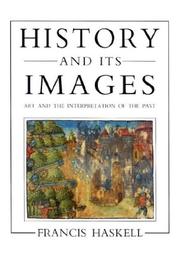| Listing 1 - 1 of 1 |
Sort by
|

ISBN: 0300055404 0300059493 9780300055405 9780300059496 Year: 1993 Publisher: New Haven (Conn.) Yale university
Abstract | Keywords | Export | Availability | Bookmark
 Loading...
Loading...Choose an application
- Reference Manager
- EndNote
- RefWorks (Direct export to RefWorks)
Over the last four centuries, historians have increasingly turned to images in their attempts to understand and visualize the past. In this wide-ranging and engrossing book, a distinguished art historian surveys the various ways that they have adopted for making use of this material, and he examines the specific objects that became available to them through excavation, the creation of private collections and public museums, easier means of travel, and the startling displacements brought about by vandalism and art exhibitions. Francis Haskell begins by discussing the antiquarians of the sixteenth and seventeenth centuries who brought to light and interpreted as historical evidence coins, sculptures, paintings discovered in the catacombs beneath Rome and other relics surviving from earlier ages. He explains that, in the eighteenth century, historians gradually began to acknowledge the significance of such visual sources and to draw on them in order to validate and give colour to their narratives or to utilize them as foundation stones for a new branch of learning - the history of culture. Later writers followed the example of Michelet in making inferences from the visual arts to indicate the whole mentality of an age, while (more erratically) others saw in them the harbingers of political, religious or social upheavals. Haskell concludes by discussing those cultural historians of the nineteenth and early twentieth centuries, Burckhardt and Huizinga above all, who did not merely give the visual arts a prominent and necessary place in their interpretations of the past, but in some ways actually interpreted the past through the visual arts.
History as a science --- historiography --- history [discipline] --- Iconography --- History of civilization --- anno 1500-1799 --- anno 1800-1999 --- Art and history --- Art et histoire --- Geschiedenis en kunst --- Histoire et art --- History and art --- Kunst en geschiedenis --- History --- Histoire --- Sources --- --Sémiologie --- --Sources --- --Méthodologie --- 7.044 --- 7.074 --- -Annals --- Auxiliary sciences of history --- History in art --- Iconografie: geschiedkundige voorstellingen; staatshandelingen; veldslagen --- Kunstverzameling. Activiteiten van verzamelaars --- Art and history. --- Sources. --- -Iconografie: geschiedkundige voorstellingen; staatshandelingen; veldslagen --- 7.074 Kunstverzameling. Activiteiten van verzamelaars --- 7.044 Iconografie: geschiedkundige voorstellingen; staatshandelingen; veldslagen --- -History and art --- Annals --- Historical source material --- Historical sources --- Primary sources (Historical sources) --- Source material, Historical --- Sources, Historical --- --Art and history. --- CDL --- 7.03 --- Historiography --- Use of --- Visual arts --- --Art and history --- History - Sources --- Sémiologie --- Méthodologie
| Listing 1 - 1 of 1 |
Sort by
|

 Search
Search Feedback
Feedback About
About Help
Help News
News